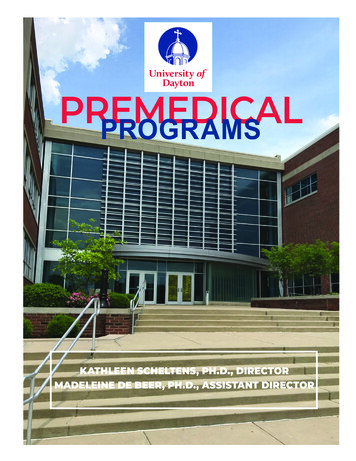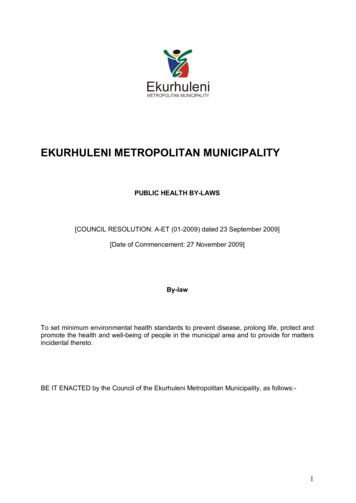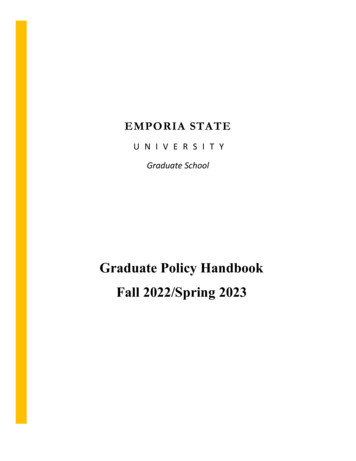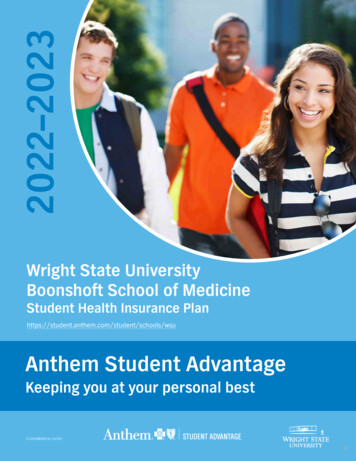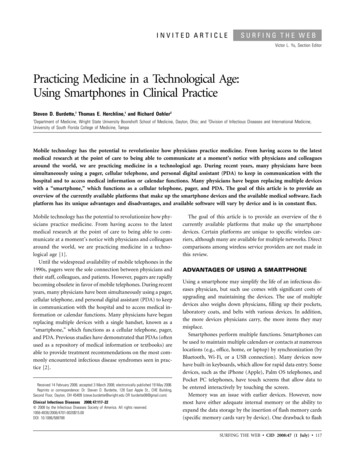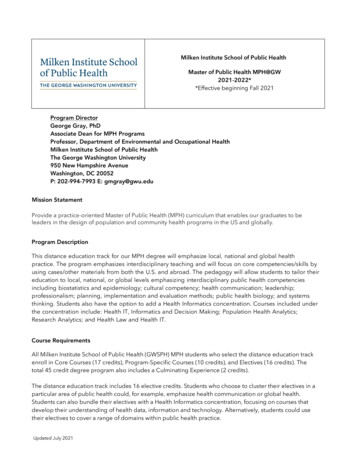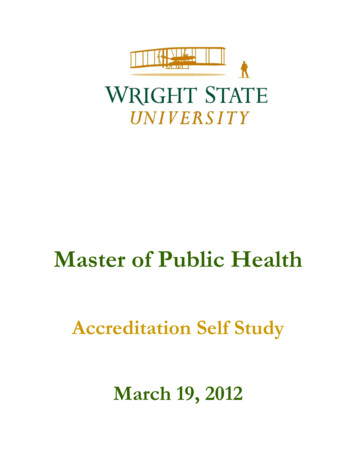
Transcription
Master of Public HealthAccreditation Self StudyMarch 19, 2012
Table of ContentsPageIntroduction . 31.0 The Public Health Program . 41.1 Mission . 41.2 Evaluation and Planning. 101.3 Institutional Environment . 161.4 Organization and Administration . 221.5 Governance . 271.6 Resources . 322.0 Instructional Programs . 422.1 Master of Public Health Degree . 422.2 Program Length. 432.3 Public Health Core Knowledge . 442.4 Practical Skills . 462.5 Culminating Experience . 542.6 Required Competencies . 602.7 Assessment Procedures . 642.8 Academic Degrees. 712.9 Doctoral Degrees . 722.10 Joint Degrees. 732.11 Distance Education or Executive Degree Programs . 753.0 Creation, Application and Advancement of Knowledge . 763.1 Research . 763.2 Service . 863.3 Workforce Development . 974.0 Faculty, Staff and Students . 1004.1 Faculty Qualifications . 1004.2 Faculty Policies and Procedures. 1074.3 Faculty and Staff Diversity . 112Wright State University1Master of Public Health Program Self-Study
Page4.4 Student Recruitment and Admissions . 1164.5 Student Diversity. 1214.6 Advising and Career Counseling. 125Appendices. 128Wright State University2Master of Public Health Program Self-Study
The Wright State University Master of Public Health Degree ProgramThe Master of Public Health (MPH) degree program is provided by the Center for Global Health (CGH),which is housed within the Department of Community Health, Boonshoft School of Medicine at WrightState University (WSU). Starting with just a handful of students at its launch in 2004, the MPH programhas grown to become the dominant responsibility of the CGH. CGH also supports medical studenteducation and curriculum development in prevention and population health, directs the MD/MPH andMD/MBA programs, and offers MPH courses as electives to graduate students in other disciplines. Inpartnership with the Raj Soin College of Business, CGH also provides a Certificate in Health CareManagement program.The MPH program is a community-responsive educational program serving a broad definition of publichealth. It is multi-professional and interdisciplinary in scope, facilitating learning among a diversestudent population. The WSU MPH program primarily serves a multi-county region in western Ohio, butalso attracts students from outside the region and internationally. The community-based aspect ofmission attainment is achieved through both student engagement in community centered and directedlearning as well as a faculty that is part of the practice-based community. Classes are offered primarily inthe evening to make the program available to in-career professionals as well as traditional students. Theprogram is interdisciplinary, with students coming from a variety of fields including public health,environmental science, nursing, sociology, medicine, education, and business administration. Programfaculty represent a diverse array of multi-professionalism including public health, nutrition, medicine,veterinary medicine, dentistry, public safety, education, biostatistics, environmental health, healthpolicy, communications, sociology, demography, education, and business administration. This programwas originally created to support the public health workforce needs of the region in 2004. Since itsbeginning, the WSU MPH has remained a partnership between the University and the public healthcommunity. Initial students tended to be mid-career professionals with a mean age in the late thirties.Over time, the student body has become progressively younger and more diverse, as increasingnumbers of students come directly from undergraduate degree programs, seeking careers in publichealth and related disciplines.There are currently 79 active MPH students, 120 MPH alumni, 8 full-time faculty, and 46 part-timefaculty. Classrooms and faculty offices are located at the Center for Global Health. Nearly all MPHclasses are taught at the CGH facility, and all full-time faculty and three part-time faculty have offices atCGH. The CGH facility is located at the Miami Valley Research Park, which is situated on 1,250 acres inthe eastern Dayton suburban communities of Beavercreek and Kettering. The non-profit park is auniversity-related research park affiliated with four local academic institutions including: Central StateUniversity, Sinclair Community College, University of Dayton, and Wright State University. The CGH siteis within 9 miles of the WSU main campus, and is easily accessible by highway from all points inMontgomery, Greene, Clark, Butler, and Warren Counties, and beyond.Wright State University3Master of Public Health Program Self-Study
1.0 The Public Health Program1.1 Mission. The program shall have a clearly formulated and publicly stated mission with supportinggoals and objectives. The program shall foster the development of professional public health values,concepts and ethical practice.1.1.a) A clear and concise mission statement for the program as a whole.MissionTo advance the public health of western Ohio and beyond by providing interdisciplinary graduateeducation, research, service, and leadershipVisionTo be the Master of Public Health degree program of choice for professionals who are committed tocommunity and global health leadership1.1.b) One or more goal statements for each major function by which the program intends to attain itsmission, including instruction, research, and service.InstructionGoal 1: To provide all MPH students with graduate-level education in core courses, specificconcentration courses, and in applied researchThe WSU MPH program provides quality education across core curriculum (seven required courses), fourconcentrations (public health management, health promotion and education, emergency preparedness,and global health) and research and service opportunities including practice placement and culminatingexperiences.Research (see Table 3.1.d)Goal 1: To foster the requisite skills necessary for students to successfully engage in applied publichealth researchStudents are required to participate in public health related applied research. Each student mustcomplete a minimum of 8 credit hours of research under the supervision of a team comprised of afaculty chair, a faculty reader, and an optional community-based practitioner.Goal 2: To conduct original research relevant to each core faculty member’s area of expertiseAll faculty members are expected to be involved in research in their field of expertise and areencouraged to seek and receive extramural funding. Junior faculty are eligible to seek seed grants inpartnership with both the Boonshoft School of Medicine and the Office of Research and SponsoredPrograms. Senior faculty are encouraged to conduct on-going research and are eligible to seek asabbatical every seven (7) years.Service (see Table 3.2.c)Goal 1: Faculty will participate in service related activitiesIt is an expectation of the MPH program that all faculty and professional staff engage in some aspect ofservice that directly benefits the community. Faculty are encouraged and supported in being activemembers of the local, state, and national communities (see Table 3.2.b-1). The program recognizes thatWright State University4Master of Public Health Program Self-Study
faculty serve the university by serving the community, and faculty are allowed to participate in serviceactivities that occur during regular working hours while continuing to be paid as university employees.Goal 2: The MPH program will meet the needs of the public health workforce in our communityThe MPH program at Wright State University was established to meet the needs of the local publichealth workforce. As such, the program continues to provide educational opportunities to public healthprofessionals seeking the graduate degree, as well as workforce development programs and initiativesfor non-degree seeking local public health professionals.Goal 3: Students will be made aware of opportunities for collaboration between the MPH program andcommunity organizationsStudents are encouraged to provide service through announcements posted physically on a bulletinboard or through the student listserv, as faculty and staff become aware of opportunities. Studentsmust complete a culminating experience as part of the requirements for graduation from the MPHprogram; many of these culminating experiences involve the student providing a service for acommunity agency.Goal 4: MPH faculty and students will consult with community organizations to address a communityhealth needFaculty serve as a resource to community members and agencies and frequently consult with them tohelp address public health needs identified by the community (see Table 3.2.b-3).1.1.c) A set of measurable objectives relating to each major function through which the programintends to achieve its goals of instruction, research and service.Instruction Objective: To provide all MPH students with a high quality graduate-level education as theycomplete their coursework and applied research Class size in MPH courses will be limited to enhance the educational experience of thestudentso Courses will be offered to provide flexibility in scheduling and so that students can reasonablybalance their course requirementso Goal: All MPH core courses will be offered in at least two quarters each academic yearCourses will not be simply theoretical, but will require students to demonstrate that they havelearned applied skills necessary in public healtho Goal: All MPH core courses will average equal to or less than 25 students eachacademic yearGoal: Seventy percent of core courses will require students to demonstrate an appliedor analysis skill as a graded assignmentStudents will demonstrate proficiency in the seven core courses by maintaining a 3.0 or higheroverall GPA for all core coursesoGoal: 100% of students have a 3.0 or higher overall GPA in core courses upongraduationWright State University5Master of Public Health Program Self-Study
Students will demonstrate proficiency in a concentration area by maintaining a 3.0 or higheroverall GPA for all concentration classeso Members of the local public health leadership will address all students as part of theirclassroom experienceo Goal: 100% of students have a 3.0 or higher overall GPA in concentration classes upongraduationGoal: At least two health commissioners will lecture to students in the core coursesMPH students will take classes from a multi-disciplinary facultyoGoal: Throughout the program, all students will take courses from faculty representingat least five academic disciplines or professionsResearch Objective 1: To foster the requisite skills necessary for students to successfully engage inapplied public health research Students will meet at least 6 of the 12 Tier 1 Analytical/Assessment Skills (1A) in the CoreCompetencies for Public Health ges/Core Public Health Competencies.aspx)o Goal: 85% of graduating students will meet at least 6 of the 12 Tier 1Analytical/Assessment Skills in their Culminating ExperienceOutstanding students will present their research as an author or co-author at a public healthmeeting, conference, workshop, or other public venueoGoal: 25% of students will present their research at a public health meeting,conference, workshop, or other public venueResearch Objective 2: To foster original research relevant to each faculty member’s area of expertise Faculty are expected to balance both a teaching and research load as appropriate to their classschedulesoGoal: 75% of all full-time core faculty will publish as an author or co-author at least 2articles, abstracts, book chapters, or reports to a peer reviewed journal or publisheroGoal: 75% of all full-time core faculty will present as an author or co-author at leasttwo public health meetings, conferences, workshops, or conventionsoGoal: 75% of all full-time core faculty will submit a public health proposal for internalor external fundingoGoal: 75% of all full-time core faculty will receive internal or external funding for apublic health projectService Objective 1: Faculty will participate in service related activitiesoGoal: 90% of faculty will participate in local, state, and/or national service activitiesWright State University6Master of Public Health Program Self-Study
Service Objective 2: The MPH program will address the needs of the public health workforce in ourcommunityoGoal: At least two (2) continuing education programs per year will be conducted formembers of the community and public health workforceService Objective 3: Students will be made aware of opportunities for collaboration between the MPHprogram and community organizationsoGoal: 100% of students will be aware of collaboration opportunities through practiceplacement and culminating experience orientationService Objective 4: MPH faculty and students will consult with community organizations to address acommunity health needoGoal: Work with at least five (5) community health organizations per year1.1.d) A description of the manner in which mission, goals, and objectives are developed, monitored,and periodically revised and the manner in which they are made available to the public.The need for an MPH program at WSU was established in 2001 and the first class matriculated in 2004.A group of health commissioners had voiced extreme concern about the regional workforce’s lack ofpublic health training and proficiency. They appealed to the WSU Boonshoft School of Medicineleadership to create a MPH program. As the program developed, these health commissioners, alongwith the original advisory board, provided input into the original mission, goals, and objectives of theprogram. Now that the program has grown considerably, the composition of the advisory board includesalumni that are encouraged to suggest updates to the mission, goals, and objectives.Today, MPH program staff and faulty consider the need to update the program mission, goals andobjectives at bi-annual strategic planning meetings. If the attendees at a strategic planning meetingconclude that an update to the program’s mission and values is necessary, then there is a discussion ofthe proposed changes. Following the meeting, a faculty subcommittee develops the specific languagebased upon the previous discussion at the strategic planning meeting. The subcommittee circulates thenew mission and vision language for review and further refinement. The current mission, vision, andvalues were updated during the summer of 2011. This was the first revision since the original mission,goals, and objectives were developed at the origination of the program.The MPH administration, through the strategic planning and MPH committee meetings, utilizes variousdata resources to monitor the program’s effectiveness. Formal program objectives are developedthrough the strategic planning process; however, any MPH committee (faculty, curriculum, admissions,advisory, etc.) can suggest the creation or update of a program objective or goal. In practice, areaspecific subcommittees have been formed periodically to consider objective and goal changes under thebroad categories of instruction, research, and service. The faculty has the opportunity to review andsuggest modifications. The most recent update of the formal program objectives and goals took placeduring the summer of 2011 as part of the program’s self-study.The mission and vision of the program are readily available on the WSU MPH website:(http://www.med.wright.edu/mph), as well as in the MPH student handbook. The goals, objectives, andvalues of the program will soon be available on the WSU MPH website, in the MPH student handbookWright State University7Master of Public Health Program Self-Study
and posted on the walls of the MPH classrooms. When marketing the program, program representativesuse materials that reference the mission and vision of the program.1.1.e) A statement of values that guide the program, with a description of how the values aredetermined and operationalized.1. Core Tier 1 public health competencies as enumerated by the Council on Linkages betweenacademic and public health re Public Health Competencies.aspx2. High quality instruction, research, and service3. Educational opportunities for in-career professionals4. Promotion of team-based approaches to address public health challenges5. Community-based learning and service models6. Partnership and collaboration with community constituencies7. Understanding of the health issues, causes, and measures to improve global health outcomesand health care systems8. High ethical standards in education, research, service, and practice9. Promotion of population health approaches in the medical care systemThe values are determined through discussion among the core faculty and reflect the program’sinstructional, research, and service goals and daily activities. During the self-study process, existingprogram values were evaluated for clarity, relevance, and continued support. Some values were revisedto reflect program changes since the previous self-study. In the 2007 self-study, Interdisciplinary aspects of public health was identified as a programvalue. The faculty committee charged with examining the values in 2011, determined that aninterdisciplinary approach to public health was inherent in the Core Tier 1 public healthcompetencies (current Value 1). Public health professionals in-training must demonstrate aninterdisciplinary set of knowledge and skills – science knowledge, as well as analytical, planning,leadership, and communication skills, to name a few. These competencies are reflected in thedesign of the MPH curriculum. The committee felt that having both the current Value 1, and theformer value of an interdisciplinary focus, was redundant. Additionally, the committee felt thatthe new Value 7 (Understanding of the health issues, causes, and measures to improve globalhealth outcomes and health care systems) requires an interdisciplinary set of competencies aswell.In the 2007 self-study, Educational delivery that stretches traditional boundaries and Educationas a central change agent in public health workforce were listed as program values. The facultycommittee determined that these values were too vague. The MPH program faculty arecommitted to the use of objectives-driven instruction, as well as innovative pedagogical andteam-based approaches in the educational process. The revisions to the two original values arereflected in the current Value 2 (High quality instruction, research, and service), Value 4(Promotion of team-based approaches to address public health challenges), and Value 8 (Highethical standards in education, research, service, and practice).The core set of faculty was asked to provide additional suggestions for new values, which were thenvetted by the entire group of core faculty.Wright State University8Master of Public Health Program Self-Study
The values are operationalized in several ways. Every student finishing the culminating experience isrequired to complete, in collaboration with faculty committee members, a checklist of the Core Tier 1public health competencies (Value 1), which is then included as an appendix in the final CE document.Value 2 is measured through student evaluation of courses and faculty, as well as annual reviews offaculty conducted by the Center Director and Department Chair. Value 3, educational opportunities forin-career professionals reflects the issue that prompted creation of the MPH program, and a value whichcontinues to be supported through collaboration with local public health departments and scholarshipfunding for in-career professionals. Team-based approaches to public health challenges (Value 4) areencouraged and evaluated as part of each faculty member’s annual evaluation and through thepromotion of team-based research opportunities to students. Values 5 and 6 reflect continued supportfor community collaboration, which has been enhanced further since the integration of the Center forHealthy Communities in 2011. Value 7 reflects the focus of the global health concentration. Value 8 ispromoted through discussion among faculty and with students about ethical standards in research,service, and practice, as well as academic integrity in the educational environment. Value 9 isoperationalized through faculty’s continued teaching, collaboration, and student mentoring in thepopulation health competencies with the Boonshoft School of Medicine.1.1.f) Assessment of the extent to which this criterion is met.Strengths: As the program has grown, it has updated its mission, vision, goals, and objectives. Theprogram prominently publicizes the mission and vision statements and they both reflect its currentdirection. The program has worked through its committee structure to monitor and update the goalsand objectives. The carefully selected goals and objectives clearly promote the mission and vision.Weaknesses: The student’s awareness of the updated mission, vision, goals, objectives, and valuesneeds improvement. New students receive a copy of the most recent version of the MPH studenthandbook at orientation. Current students need to be informed of the updates which will be done byhaving them posted on the walls of the MPH classrooms and on the MPH website.Opportunities: Although it has a brief history, the program has relied on a 5–year review cycle to updateits mission, goals, objectives, and values. The review process includes participation from constituencygroups such as alumni and community public health leaders. It also allows for short-term updates if theybecome necessary.The criterion is met.Wright State University9Master of Public Health Program Self-Study
1.2 Evaluation and Planning. The program shall have an explicit process for evaluating and monitoring itsoverall efforts against its mission, goals, and objectives; for assessing the program’s effectiveness inserving its various constituencies; and for planning to achieve its mission in the future.1.2.a) Description of the evaluation procedures and planning processes used by the program, includingan explanation of how constituent groups are involved in these processes.While the MPH program administration is ultimately responsible for evaluation and future planning,various MPH committees support these functions and enact policy updates on a continuous basis. Inextraordinary circumstances, ad hoc subcommittees are formed which report to the MPH permanentcommittees. The MPH permanent committees that contribute to domain-specific evaluation andplanning functions include the following:Faculty Committee (Meets quarterly, or more often, if necessary)Purpose: To provide general information sharing for topics including faculty research, personnelchanges, course evaluations, promotion, and Delta Omega. Faculty meetings also provide anopportunity for discussion that often results in the identification of agenda items for the otherpermanent committees.Strategic Planning Meeting (Held semi-annually)Purpose: Program evaluation and strategic planning with all facultyAdvisory Board (Meets semi-annually)Purpose: To update constituent groups on program changes and performance. This committee alsodiscusses planning and opportunities for program enhancement.Admissions Committee (Meets semi-annually, or more often, if necessary)Purpose: To review and evaluate the program’s admissions policy and its executionCurriculum Committee (Meets quarterly)Purpose: To address issues pertaining to concentration and course content, competencies, theirdevelopment, modification, and quality. Other issues include CEPH compliance and graduation issues.Program Evaluation & Accreditation Committee (Meets annually, or more often, if necessary)Purpose: Program planning, evaluation, and accreditation monitoring and reportingMembers of the MPH faculty, administrators, and constituents are encouraged to add items to themeeting agendas of the above committees. In the case of the MPH strategic planning meeting, one ofthe semi-annual meetings is an off-site retreat. At this retreat, attendees assess and, if necessary, alterthe mission and vision of the program. In addition, the retreat allows for both a reporting by directorson the concentrations, culminating experience, and practice placements under their supervision and anopportunity to discussion future programmatic enhancements.Both formally and informally, constituent groups (current students, program alumni, members of thepublic health community, other WSU department faculty) play an active role in the evaluation andplanning of the MPH program. Formally, members of these groups contribute as representatives on theabove MPH committees that engage in program evaluation and planning. Specifically, each of theconstituent groups has representation on the MPH advisory board. Two current students also serve asWright State University10Master of Public Health Program Self-Study
members on both the admissions and curriculum committees. In addition, a community representativeis on the admissions committee. Besides committee representation, the program receives informalfeedback that has led to policy changes and program enhancement. These ideas can arise from everydaystudent interactions, contact with alumni, and the regular communication with the public healthcommunity through the administration of practice placements opportunities.1.2.b) Description of how the results of evaluation and planning are regularly used to enhance thequality of programs and activities.Given the fact that the WSU MPH program is still quite young, there have been a number ofopportunities where we have adapted policies to enhance the educational experience of our students.We feel that the interconnectedness of the program faculty has led to the rapid identification of issuesand that effective communication fostered by the committee structure has enabled us to evaluate whatspecific changes might improve the program. The following paragraphs describe progr
partnership with the Raj Soin College of Business, CGH also provides a Certificate in Health Care Management program. The MPH program is a community-responsive educational program serving a broad definition of public health. It is multi-professional and interdisciplinary in scope, facilitating learning among a diverse student population.




